Flexural Behavior of RC Beams Strengthened with GFRP Laminate and Retrofitting with Novelty of Adhesive Material
Abstract
:1. Introduction
2. Experimental Program
2.1. Materials
2.2. Mix Proportioning and Details of Tested Beams
2.3. Beam Preparation and GFRP Strengthening
2.3.1. Beam Preparation
2.3.2. GFRP Strengthening
2.4. Test Setup and Instrumentation
3. Results and Discussion
3.1. Failure Loads
3.2. Failure Behavior and Crack Patterns
3.3. Load–Deflection Curves of Tested Beams
3.4. Ductility of Specimens
4. Finite Element Analysis
4.1. Modeling of Material Properties
4.1.1. Concrete
4.1.2. Steel Reinforcement Bars and GFRP Laminate
4.1.3. GFRP Laminate–Concrete Interface
4.2. Boundary Conditions and Meshing
5. Comparison of the Experimental and Finite Element Results
6. Conclusions
- The geopolymer paste with and without short glass fibers outperformed epoxy in the strengthened beams. No debonding was observed between the GFRP laminate and the concrete surface, which is the most significant issue that frequently limits the strengthening of structures using GFRP laminate. On the other hand, compared with epoxy, geopolymer paste with and without short glass fibers reduced adhesive materials costs by more than 90%.
- The failure loads of beams B1-0-GPP, B2-0.60-GPP, and B3-1.2-GPP were greater than control beam B0-Control by approximately 20.80%, 25.60%, and 31.40%, respectively, whereas the failure loads of beams B4-0-EP, B5-0.6-EP, and B6-1.2-EP were greater than the control beam B0-Control by approximately 16.90%, 26.90%, and 26.10%, respectively. The results showed that increasing the SGF ratio in the GPP had a clear effect on raising the capacity of the beam due to the enhanced interfacial bond shear strength. In addition, the GPP had a great effect on increasing the failure load capacity of the tested beams.
- Based on the experimental results, no debonding occurred for laminates when using GPP as adhesive material with different SGF ratios. On the contrary, there was a debonding when using EP as adhesive material.
- The maximum deflection of the tested beams B1-0-GPP, B2-0.6-GPP, and B3-1.2-GPP was less than the control beam by approximately 14.60%, 6.90%, and 6.20%, respectively, whereas the maximum deflection of the tested beams B4-0-EP, B5-0.6-EP, and B6-1.2-EP was less than the control beam by approximately 19.30%, 5.92%, and 17.10%, respectively. This showed that the GPP as adhesive material pastes enhanced the maximum beam’s deflections better than EP.
- The ductility factor of beams B1-0-GPP, B2-0.6-GPP, and B3-1.2-GPP was larger than corresponding beams B4-0-EP, B5-0.6-EP, and B6-1.2-EP by approximately 5.80%, 13.60%, and 21.40%, respectively. This showed that the GPP as adhesive material pastes enhanced the beam’s ductility factor more than EP.
- The experimental findings and FE predictions are shown to be in good agreement. Due to the complexity of using the cohesive model in modeling the GFRP laminate–concrete interface, there was a slight variation in the results.
7. Recommendations for Future Research
Author Contributions
Funding
Institutional Review Board Statement
Informed Consent Statement
Data Availability Statement
Conflicts of Interest
References
- Attia, M.M.; El-Shaer, M.A.A.; Shawky, S.M.M.; Samaan, M.F. Replacement efficiency of steel reinforcement with FRB bars in RC beams under flexure load: Experimental and FE study. Innov. Infrastruct. Solut. 2022, 7, 281. [Google Scholar] [CrossRef]
- El Ghadioui, R.; Wagner, J.; Klein, J.; Proske, T.; Curbach, M.; Graubner, C. RC members with a flexural-strengthening layer of CFRP textile-reinforced concrete under monotonic and cyclic long-term loading. Struct. Concr. 2022, 23, 939–953. [Google Scholar] [CrossRef]
- Barros, J.; Figueiredo, F.P.; Costa, I.G.; Dourado, F. New type of CFRP reinforcement and technique for the flexural strengthening of RC balconies. Compos. Struct. 2022, 280, 114899. [Google Scholar] [CrossRef]
- Prasertsri, T.; Lenwari, A.; Thepchatri, T. Flexural Response of CFRP-Strengthened Steel Beams with Initial Bond Defects. Eng. J. 2020, 24, 115–127. [Google Scholar] [CrossRef]
- Yuan, P.; Xiao, L.; Wang, X.; Xu, G. Failure mechanism of corroded RC beams strengthened at shear and bending positions. Eng. Struct. 2021, 240, 112382. [Google Scholar] [CrossRef]
- Song, L.; Li, L.G.; Fan, C. Analysis on bending resistance of RC beams reinforced with steel bonding plates under secondary stress. Shenyang Gongye Daxue Xuebao/J. Shenyang Univ. Technol. 2021, 43, 470–475. [Google Scholar] [CrossRef]
- Jahami, A.; Temsah, Y.; Khatib, J.; Baalbaki, O.; Kenai, S. The behavior of CFRP strengthened RC beams subjected to blast loading. Mag. Civ. Eng. 2021, 103, 10309. [Google Scholar] [CrossRef]
- Abuodeh, O.R.; Abdalla, J.A.; Hawileh, R.A. Flexural strengthening of RC beams using aluminum alloy plates with mechanically-fastened anchorage systems: An experimental investigation. Eng. Struct. 2021, 234, 111969. [Google Scholar] [CrossRef]
- Abuodeh, O.R.; Hawileh, R.A.; Abdalla, J.A. Nonlinear finite element models of reinforced concrete beams strengthened in bending with mechanically fastened aluminum alloy plates. Comput. Struct. 2021, 253, 106573. [Google Scholar] [CrossRef]
- Kumar, M.V.; Muthukannan, M. Investigation of HFRC beams retrofitted using GFRP for enhancement in flexural capacity. Int. J. Manuf. Technol. Manag. 2020, 34, 1–24. [Google Scholar] [CrossRef]
- Yang, Y.; Fahmy, M.F.; Cui, J.; Pan, Z.; Shi, J. Nonlinear behavior analysis of flexural strengthening of RC beams with NSM FRP laminates. Structures 2019, 20, 374–384. [Google Scholar] [CrossRef]
- Patil, S.; Dhongade, A.V. Literature review for use of FRP in Civil Engineering. Int. Res. J. Eng. Technol. 2021, 8, 446–449. [Google Scholar]
- Ibrahim, S.S.; Kandasamy, S.; Pradeepkumar, S.; Bose, R.S.C. Effect of discrete steel fibres on strength and ductility of FRP laminated RC beams. Ain Shams Eng. J. 2021, 12, 1329–1337. [Google Scholar] [CrossRef]
- Tahmouresi, B.; Momeninejad, K.; Mohseni, E. Flexural response of FRP-strengthened lightweight RC beams: Hybrid bond efficiency of L-shape ribbed bars and NSM technique. Arch. Civ. Mech. Eng. 2022, 22, 95. [Google Scholar] [CrossRef]
- Attia, M.M.; Ahmed, O.; Kobesy, O.; Malek, A.S. Behavior of FRP rods under uniaxial tensile strength with multiple materials as an alternative to steel rebar. Case Stud. Constr. Mater. 2022, 17, e01241. [Google Scholar] [CrossRef]
- Aravind, N.; Samanta, A.K.; Thanikal, J.V.; Roy, D.K.S. An experimental study on the effectiveness of externally bonded corrugated GFRP laminates for flexural cracks of RC beams. Constr. Build. Mater. 2017, 136, 348–360. [Google Scholar] [CrossRef]
- Alam, A.; Onik, S.A.; Bin Mustapha, K.N. Crack based bond strength model of externally bonded steel plate and CFRP laminate to predict debonding failure of shear strengthened RC beams. J. Build. Eng. 2020, 27, 100943. [Google Scholar] [CrossRef]
- Radfar, S.; Foret, G.; Saeedi, N.; Sab, K. Simulation of concrete cover separation failure in FRP plated RC beams. Constr. Build. Mater. 2012, 37, 791–800. [Google Scholar] [CrossRef]
- De Maio, U.; Fabbrocino, F.; Greco, F.; Leonetti, L.; Lonetti, P. A study of concrete cover separation failure in FRP-plated RC beams via an inter-element fracture approach. Compos. Struct. 2019, 212, 625–636. [Google Scholar] [CrossRef]
- Fu, B.; Teng, J.G.; Chen, J.F.; Chen, G.M.; Guo, Y.C. Concrete Cover Separation in FRP-Plated RC Beams: Mitigation Using FRP U-Jackets. J. Compos. Constr. 2017, 21, 04016077. [Google Scholar] [CrossRef]
- Zhang, W.; Tang, Z.; Yang, Y.; Wei, J. Assessment of FRP–Concrete Interfacial Debonding with Coupled Mixed-Mode Cohesive Zone Model. J. Compos. Constr. 2021, 25, 04021002. [Google Scholar] [CrossRef]
- Zhang, F.; Gao, L.; Wu, Y.-F.; Liu, J. Flexural design of reinforced concrete structures strengthened with hybrid bonded FRP. Compos. Struct. 2021, 269, 113996. [Google Scholar] [CrossRef]
- Yazdani, N.; Aljaafreh, T.; Beneberu, E. Concrete beam flexural strengthening with anchored pre-saturated CFRP laminates. Compos. Struct. 2020, 235, 111733. [Google Scholar] [CrossRef]
- Mostofinejad, D.; Hosseini, S.M.; Tehrani, B.N.; Eftekhar, M.R.; Dyari, M. Innovative warp and woof strap (WWS) method to anchor the FRP sheets in strengthened concrete beams. Constr. Build. Mater. 2019, 218, 351–364. [Google Scholar] [CrossRef]
- Ababneh, A.N.; Al-Rousan, R.Z.; Ghaith, I.M. Experimental study on anchoring of FRP-strengthened concrete beams. Structures 2020, 23, 26–33. [Google Scholar] [CrossRef]
- Sun, W.; Liu, S.; Zhang, C. An effective improvement for enhancing the strength and feasibility of FRP spike anchors. Compos. Struct. 2020, 247, 112449. [Google Scholar] [CrossRef]
- Grelle, S.V.; Sneed, L.H. Review of Anchorage Systems for Externally Bonded FRP Laminates. Int. J. Concr. Struct. Mater. 2013, 7, 17–33. [Google Scholar] [CrossRef]
- Ibrahim, W.; Ali, W. Comparison of Anchorage Systems for Externally Bonded FRP Laminates. Int. J. Eng. Technol. 2019, 11, 1128–1135. [Google Scholar] [CrossRef]
- Al-Saoudi, A.; Kalfat, R.; Al-Mahaidi, R.; Cervenka, J.; Pryl, D. Numerical and experimental investigation into the fatigue life of FRP bonded to concrete and anchored with bidirectional fabric patches. Eng. Struct. 2021, 239, 112335. [Google Scholar] [CrossRef]
- Godat, A.; Hammad, F.; Chaallal, O. State-of-the-art review of anchored FRP shear-strengthened RC beams: A study of influencing factors. Compos. Struct. 2020, 254, 112767. [Google Scholar] [CrossRef]
- Eslami, A.; Moghavem, A.; Shayegh, H.R.; Ronagh, H.R. Effect of FRP stitching anchors on ductile performance of shear-deficient RC beams retrofitted using FRP U-wraps. Structures 2020, 23, 407–414. [Google Scholar] [CrossRef]
- Zhang, S.; Ke, Y.; Smith, S.; Zhu, H.; Wang, Z. Effect of FRP U-jackets on the behaviour of RC beams strengthened in flexure with NSM CFRP strips. Compos. Struct. 2021, 256, 113095. [Google Scholar] [CrossRef]
- Abdallah, M.; Al Mahmoud, F.; Khelil, A.; Mercier, J.; Almassri, B. Assessment of the flexural behavior of continuous RC beams strengthened with NSM-FRP bars, experimental and analytical study. Compos. Struct. 2020, 242, 112127. [Google Scholar] [CrossRef]
- ACI. ACI SP 275. In Fiber-Reinforced Polymer Reinforcement for Concrete Structures 10th International Symposium, Tampa, FL, USA, 2–4 April 2011; ACI: Farmington Hills, MI, USA, 2011. [Google Scholar]
- Yuan, C.; Chen, W.; Pham, T.M.; Hao, H.; Chen, L.; Zhang, M. New epoxy anchor for better bonding between FRP sheets and concrete. Constr. Build. Mater. 2020, 248, 118628. [Google Scholar] [CrossRef]
- Mostofinejad, D.; Mofrad, M.H.; Hosseini, A.; Mofrad, H.H. Investigating the effects of concrete compressive strength, CFRP thickness and groove depth on CFRP-concrete bond strength of EBROG joints. Constr. Build. Mater. 2018, 189, 323–337. [Google Scholar] [CrossRef]
- Jiang, C.; Wan, B.; Wu, Y.F.; Omboko, J. Epoxy interlocking: A novel approach to enhance FRP-to-concrete bond behavior. Constr. Build. Mater. 2018, 193, 643–653. [Google Scholar] [CrossRef]
- Almutairi, A.L.; Tayeh, B.A.; Adesina, A.; Isleem, H.F.; Zeyad, A.M. Potential applications of geopolymer concrete in construction: A review. Case Stud. Constr. Mater. 2021, 15, e00733. [Google Scholar] [CrossRef]
- Mackenzie, K.; Welter, M. Geopolymer (aluminosilicate) composites: Synthesis, properties and applications. In Advances in Ceramic Matrix Composites; Victoria University of Wellington: Wellington, New Zealand, 2014; pp. 445–470. [Google Scholar] [CrossRef]
- Singh, N.; Middendorf, B. Geopolymers as an alternative to Portland cement: An overview. Constr. Build. Mater. 2020, 237, 117455. [Google Scholar] [CrossRef]
- Dong, M.; Feng, W.; Elchalakani, M.; Li, G.; Karrech, A.; Sheikh, N.M. Material and glass-fibre-reinforced polymer bond properties of geopolymer concrete. Mag. Concr. Res. 2020, 72, 509–525. [Google Scholar] [CrossRef]
- Abdulrahman, H.; Muhamad, R.; Visintin, P.; Shukri, A.A. Mechanical properties and bond stress-slip behaviour of fly ash geopolymer concrete. Constr. Build. Mater. 2022, 327, 126909. [Google Scholar] [CrossRef]
- Saranya, P.; Nagarajan, P.; Shashikala, A.P. Experimental Investigation on Bond Strength Properties of Geopolymer Concrete. In Advances in Civil Engineering; Lecture Notes in Civil Engineering; Singh, R.M., Sudheer, K.P., Kurian, B., Eds.; Springer: Singapore, 2021; Volume 83. [Google Scholar] [CrossRef]
- Rajak, D.K.; Pagar, D.D.; Kumar, R.; Pruncu, C.I. Recent progress of reinforcement materials: A comprehensive overview of composite materials. J. Mater. Res. Technol. 2019, 8, 6354–6374. [Google Scholar] [CrossRef]
- Mohamedou, M.; Zulueta, K.; Chung, C.N.; Rappel, H.; Beex, L.; Adam, L.; Arriaga, A.; Major, Z.; Wu, L.; Noels, L. Bayesian identification of Mean-Field Homogenization model parameters and uncertain matrix behavior in non-aligned short fiber composites. Compos. Struct. 2019, 220, 64–80. [Google Scholar] [CrossRef]
- Li, Z.; Liu, Z.; Lei, Z.; Zhu, P. An innovative computational framework for the analysis of complex mechanical behaviors of short fiber reinforced polymer composites. Compos. Struct. 2021, 277, 114594. [Google Scholar] [CrossRef]
- Sharma, K.K.; Kushwaha, J.; Kumar, K.; Singh, H.; Shrivastava, Y. Fabrication and testing of hybrid fibre reinforced composite: A comprehensive review. Aust. J. Mech. Eng. 2022, 1–17. [Google Scholar] [CrossRef]
- Abaqus, S. CAE 6.14 User’s Manual Dassault; Systémes Inc. Provid.: Johnston, RI, USA, 2014; Volume IV. [Google Scholar]
- ASTM C494; Standard Specification for Chemical Admixtures for Concrete. ASTM Int.: West Conshohocken, PA, USA, 2019; Volume 04.
- Attia, M.M.; Abdelsalam, B.A.; Amin, M.; Agwa, I.S.; Abdelmagied, M.F. Metal-Nails Waste and Steel Slag Aggregate as Alternative and Eco-Friendly Radiation Shielding Composites. Buildings 2022, 12, 1120. [Google Scholar] [CrossRef]
- ACI Committee 440. ACI440.2R-17 Guide for the Design and Construction of Externally Bonded FRP Systems for Strengthening Concrete Structures Reported by ACI Committee 440. Am. Concr. Inst. 2017, 5, 45. [Google Scholar]
- American Concrete Institute. ACI 318 Building Code Requirements for Structure Concrete and Commentary; American Concrete Institute ACI Committee: Farmington Hills, MI, USA, 2019. [Google Scholar]
- Hamrat, M.; Bouziadi, F.; Boulekbache, B.; Daouadji, T.H.; Chergui, S.; Labed, A.; Amziane, S. Experimental and numerical investigation on the deflection behavior of pre-cracked and repaired reinforced concrete beams with fiber-reinforced polymer. Constr. Build. Mater. 2020, 249, 118745. [Google Scholar] [CrossRef]
- Almusallam, T.; Al-Salloum, Y.; Alsayed, S.; Iqbal, R.; Abbas, H. Effect of CFRP strengthening on the response of RC slabs to hard projectile impact. Nucl. Eng. Des. 2015, 286, 211–226. [Google Scholar] [CrossRef]
- Radnić, J.; Matešan, D.; Grgić, N.; Baloević, G. Impact testing of RC slabs strengthened with CFRP strips. Compos. Struct. 2015, 121, 90–103. [Google Scholar] [CrossRef]
- Guo, Z.; Cao, S.; Sun, W.; Lin, X. Experimental study on bond stress-slip behaviour between FRP sheets and concrete. In Proceedings of the International Symposium on Bond Behaviour of FRP in Structures, Hong Kong, China, 7–9 December 2005. [Google Scholar]
- Obaidat, Y.T.; Heyden, S.; Dahlblom, O. The effect of CFRP and CFRP/concrete interface models when modelling retrofitted RC beams with FEM. Compos. Struct. 2010, 92, 1391–1398. [Google Scholar] [CrossRef]
- Jahami, A.; Temsah, Y.; Khatib, J.; Sonebi, M.; Ali, J. Numerical study for the effect of carbon fiber reinforced polymers (CFRP) sheets on structural behavior of posttensioned slab subjected to impact loading. In Proceedings of the Symposium on Concrete Modelling–CONMOD2018, Delft, The Netherlands, 27–30 August 2018; pp. 259–267. [Google Scholar]

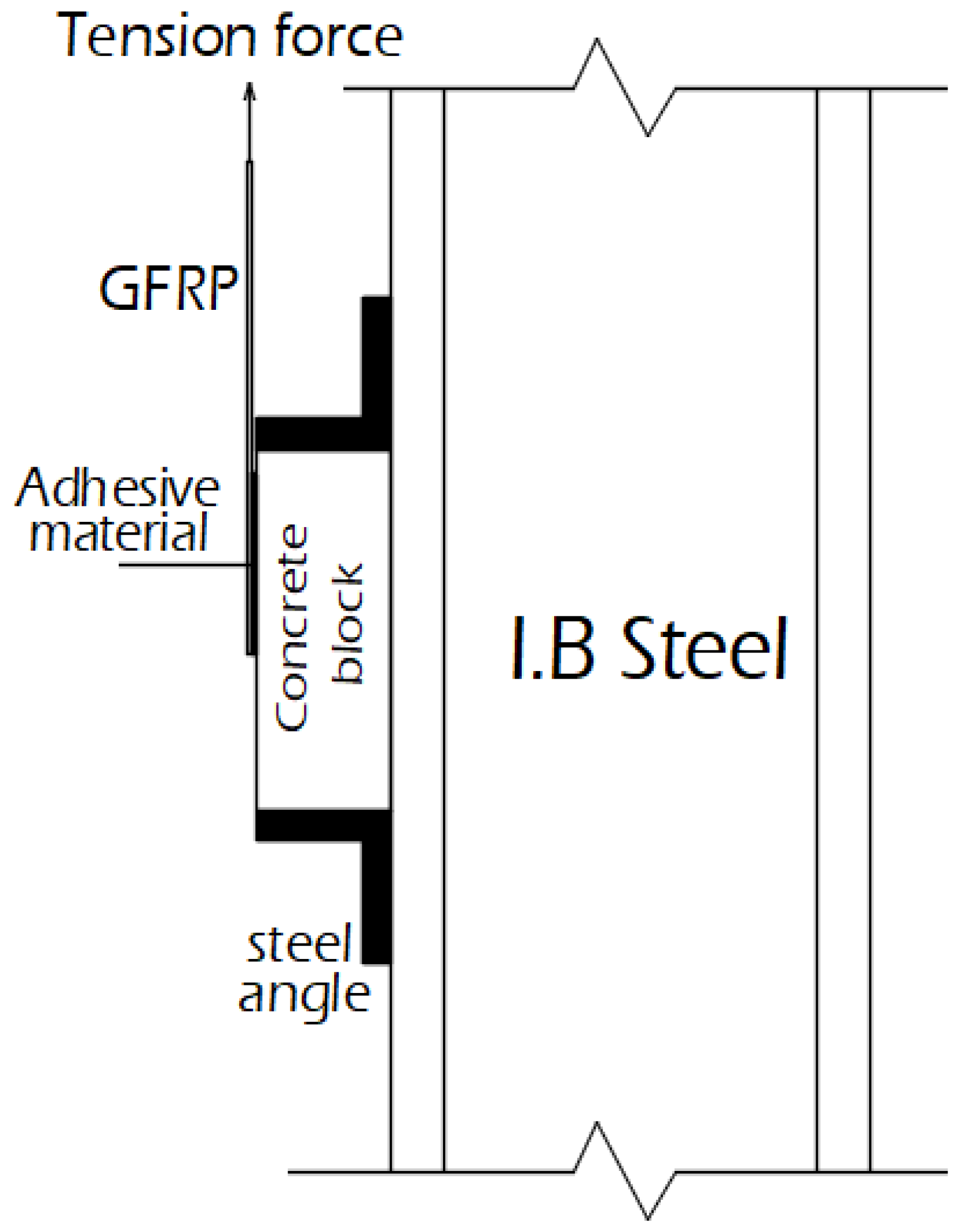
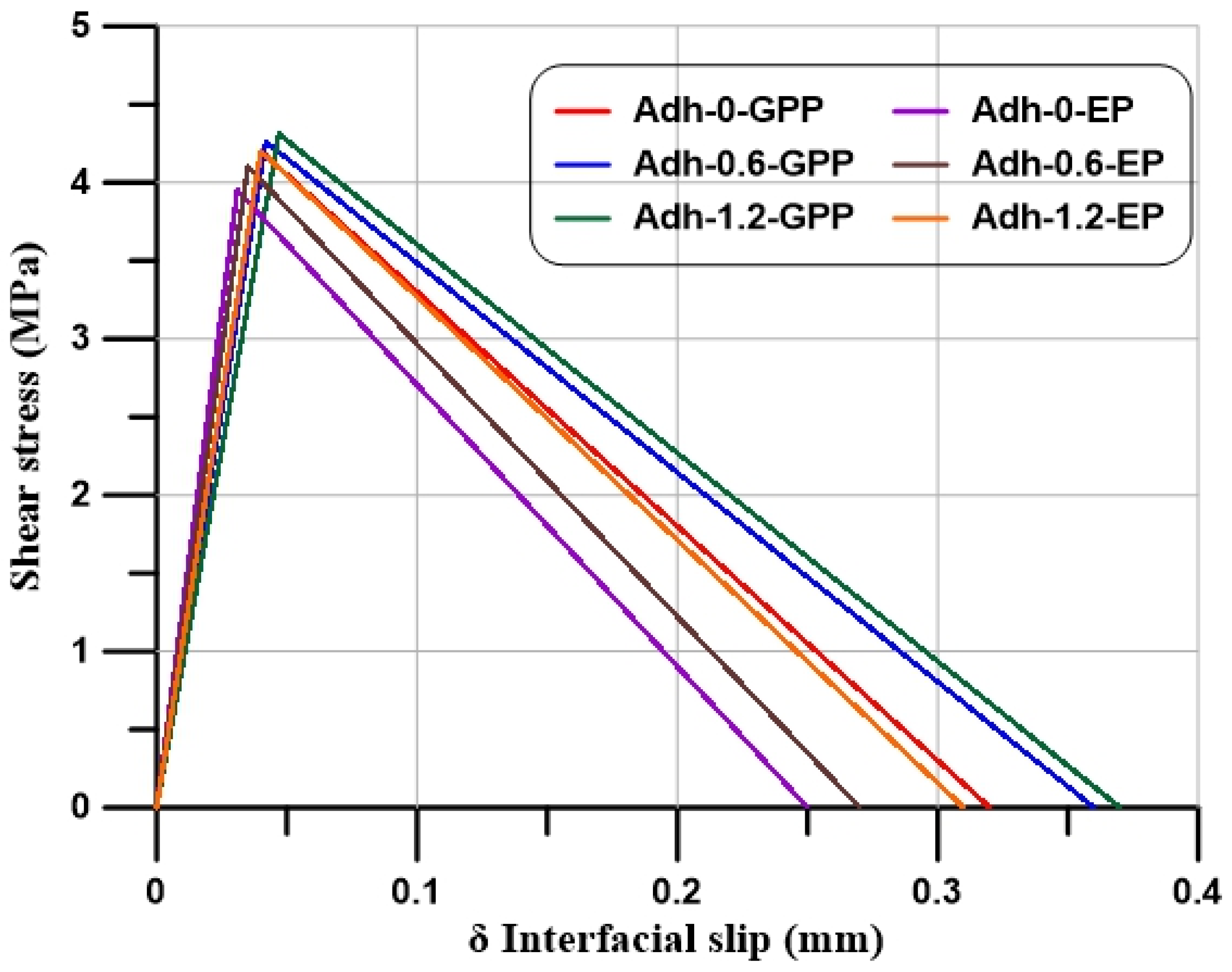





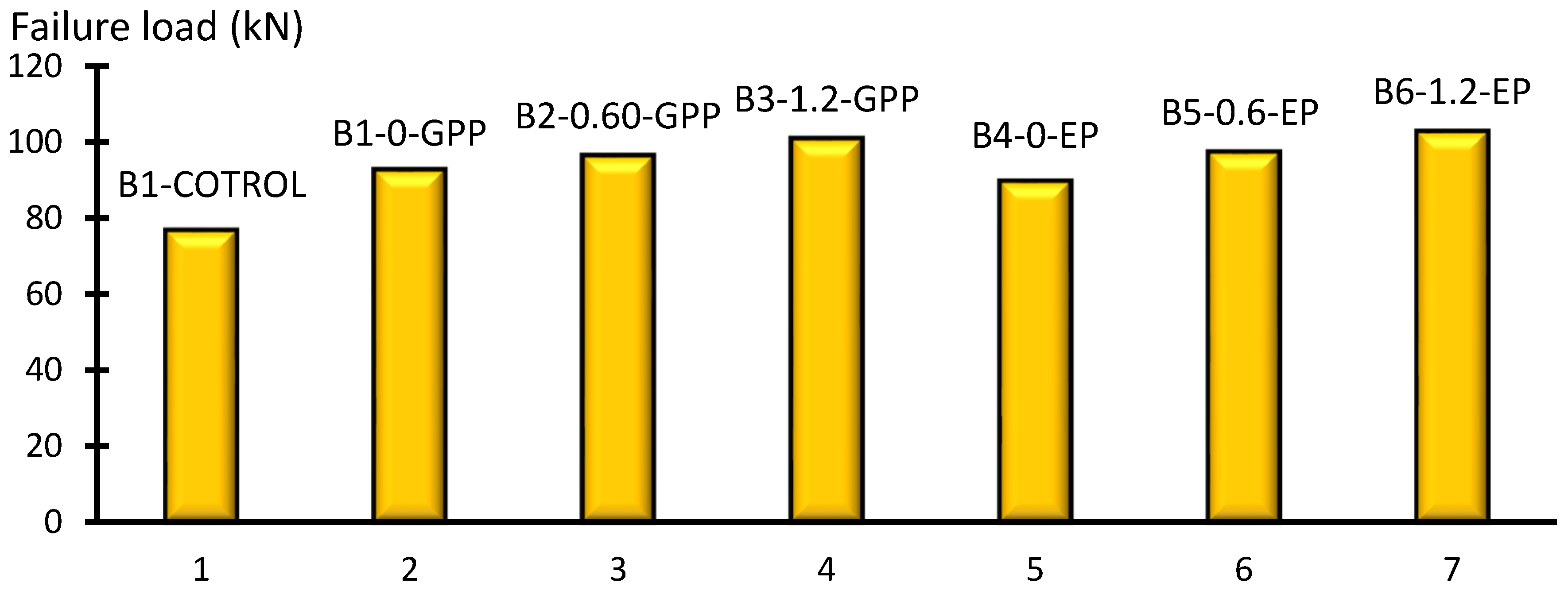







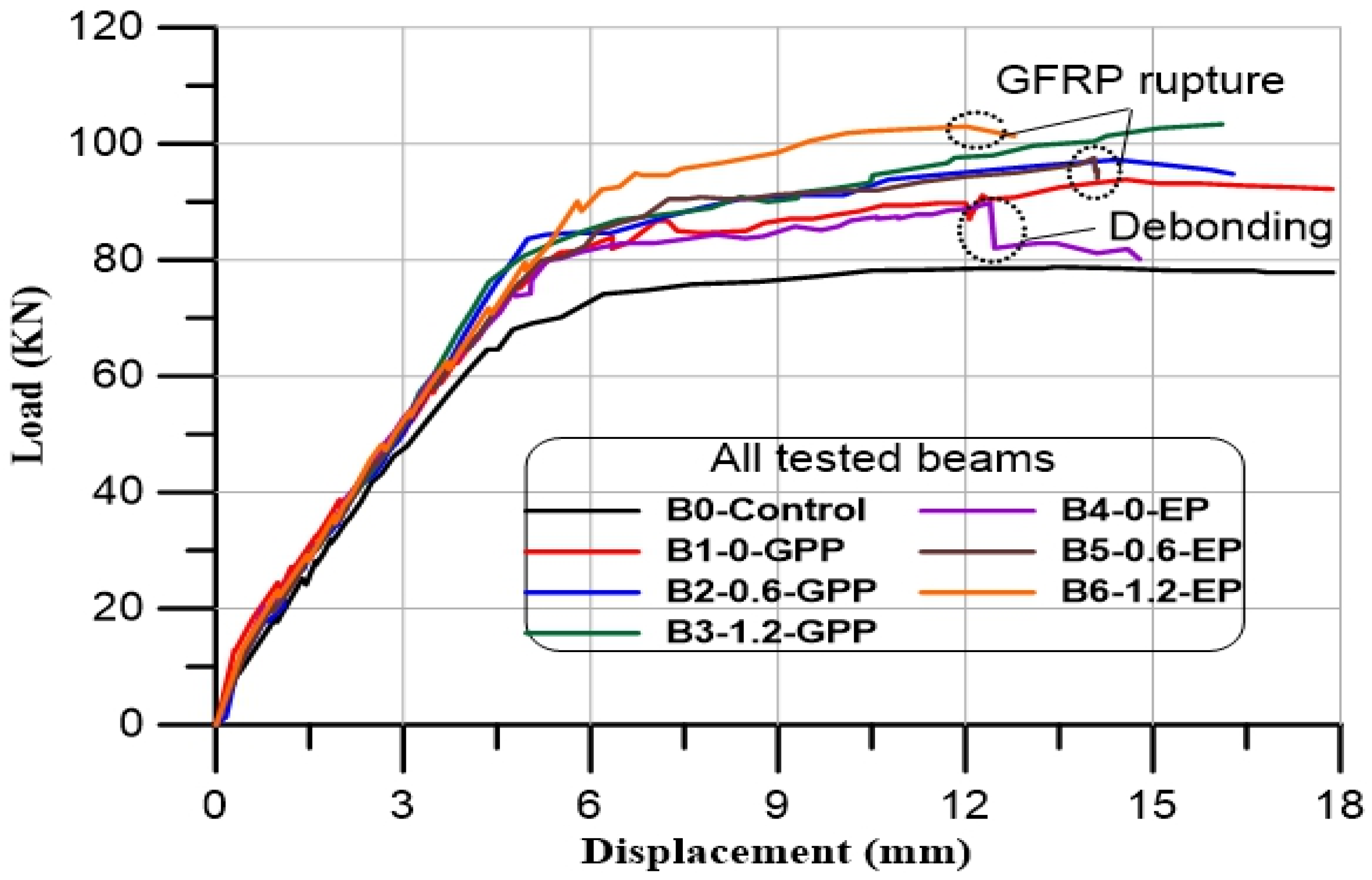



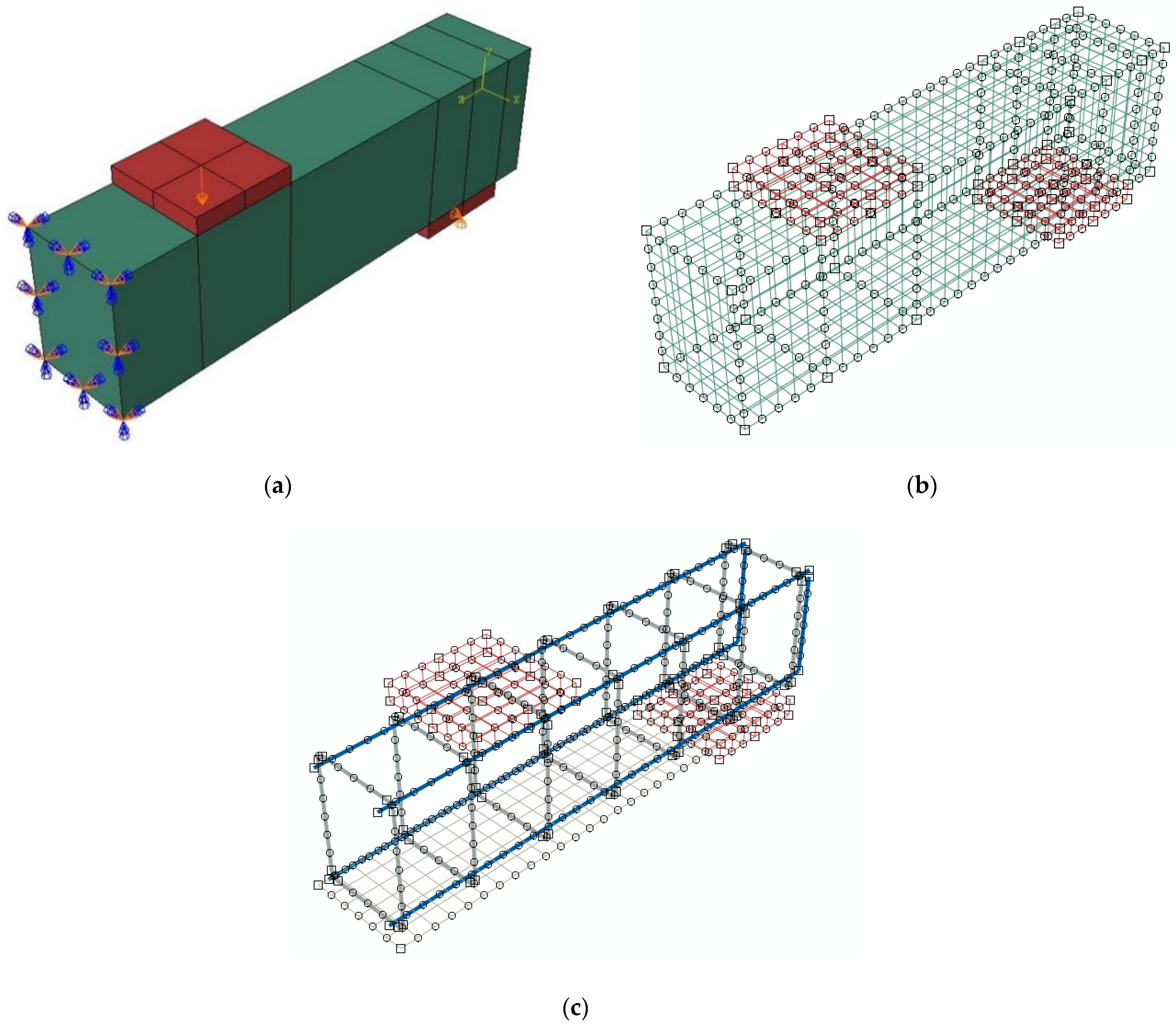
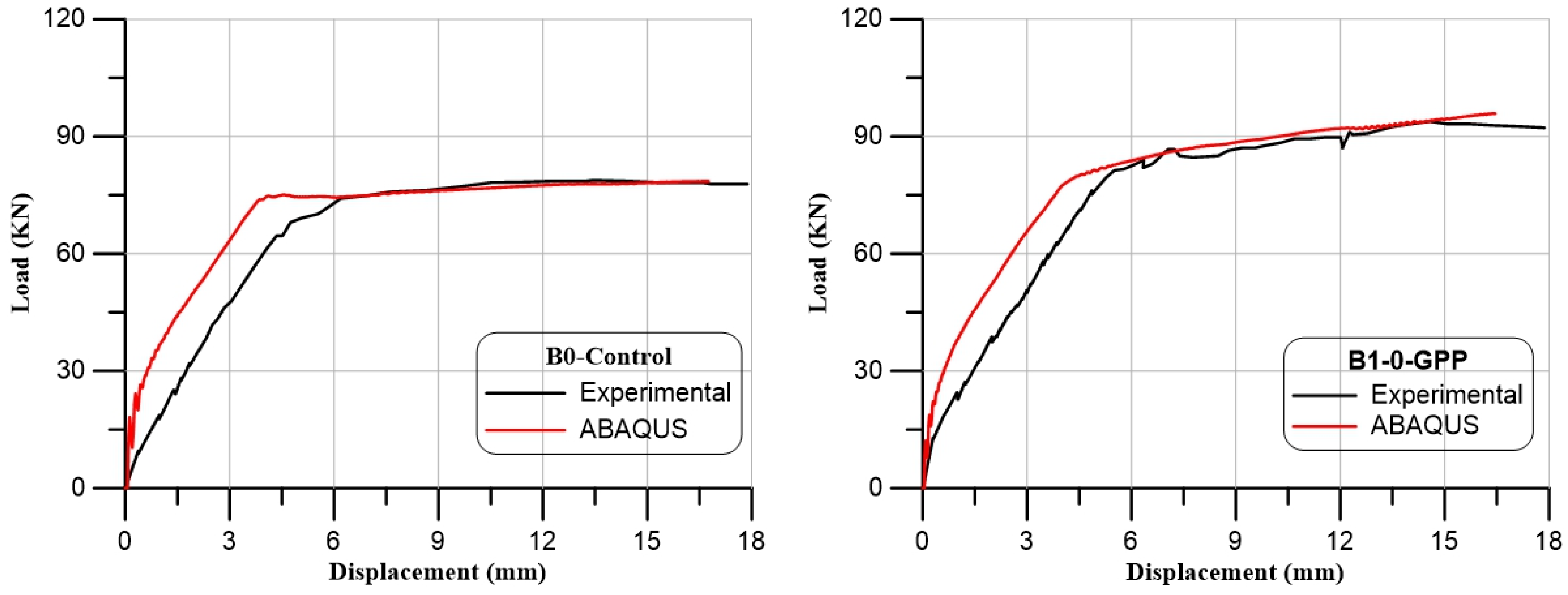



| Composition | OPC | FA |
|---|---|---|
| Chemical properties | ||
| SiO2 | 19.39 | 57.2 |
| Al2O3 | 4.13 | 24.4 |
| CaO | 55.66 | 2.2 |
| Fe2O3 | 4.70 | 7.1 |
| MgO | 1.70 | 2.4 |
| K2O | 0.28 | 3.4 |
| Na2O | 0.31 | 0.4 |
| SO3 | 3.90 | 0.3 |
| Physical properties | ||
| Specific gravity | 3.10 | 2.8 |
| Cement (kg/m3) | Water (Liter) | Fine Aggregate (kg/m3) | Coarse Aggregate (kg/m3) | Super Plasticizer (Liter) |
|---|---|---|---|---|
| 350 | 147 | 870 | 1270 | 5.25 |
| Group | Bonding Material | Beam ID | SGF % |
|---|---|---|---|
| A | - | B0-Control | 0 |
| B | GPP | B1-0-GPP | 0 |
| B2-0.6-GPP | 0.6 | ||
| B3-1.2-GPP | 1.2 | ||
| C | EP | B4-0-EP | 0 |
| B5-0.6-EP | 0.6 | ||
| B6-1.2-EP | 1.2 |
| Beam | Pcr (kN) | Py (kN) | Pu (kN) | Δy (mm) | Δu (mm) | Δu/Δy | Failure Mode |
|---|---|---|---|---|---|---|---|
| B0-Control | 24.0 | 70.14 | 76.90 | 5.50 | 17.70 | 3.21 | Concrete crushing |
| B1-0-GPP | 25.0 | 76.98 | 92.90 | 4.97 | 13.60 | 2.74 | Concrete crushing |
| B2-0.6-GPP | 26.0 | 78.68 | 96.58 | 4.64 | 15.93 | 3.43 | Concrete crushing |
| B3-1.2-GPP | 26.0 | 79.71 | 101.03 | 4.37 | 15.30 | 3.23 | Concrete crushing |
| B4-0-EP | 26.0 | 75.6 | 89.87 | 4.77 | 12.36 | 2.59 | Debonding-C.C. S * |
| B5-0.6-EP | 27.0 | 76.1 | 97.58 | 4.65 | 14.06 | 3.02 | GFRP rupture |
| B6-1.2-EP | 26.0 | 76.9 | 102.96 | 4.55 | 12.10 | 2.66 | GFRP rupture |
| Dilation Angle (Ψ) | 35° |
| Eccentricity (e) | 0.10 |
| fbo/fco | 1.16 |
| K | 0.66 |
| Viscosity Parameter | 0.00005 |
| Modulus of Elasticity, Es (GPa) | 202 |
| Yield strength, fy (MPa) | 410 |
| Ultimate strength fu (Mpa) | 520 |
| Poisson’s ratio | 0.20 |
| Modulus of Elasticity, E (GPa) | 72 |
| Tensile strength (GPa) | 2.5 |
| Failure Load, kN | Maximum Beam Displacement at the Ultimate Load (mm) | |||||||
|---|---|---|---|---|---|---|---|---|
| Finite Element | EXP./Finite Element (Medium) | Finite Element | EXP./Finite Element (Medium) | |||||
| Fine | Medium | Coarse | Fine | Medium | Coarse | |||
| B0-Control | 79.60 | 78.51 | 76.54 | 0.98 | 17.07 | 16.6 | 15.87 | 1.07 |
| B1-0-GPP | 97.11 | 95.85 | 93.53 | 0.97 | 16.86 | 16.4 | 15.67 | 0.83 |
| B2-0.6-GPP | 101.92 | 100.61 | 98.20 | 0.96 | 15.45 | 15.0 | 14.30 | 1.06 |
| B3-1.2-GPP | 104.43 | 103.1 | 100.64 | 0.98 | 14.64 | 14.2 | 13.52 | 1.07 |
| B4-0-EP | 95.85 | 94.6 | 92.31 | 0.95 | 13.43 | 13 | 12.34 | 0.95 |
| B5-0.6-EP | 103.42 | 102.1 | 99.66 | 0.95 | 13.33 | 12.9 | 12.24 | 1.09 |
| B6-1.2-EP | 106.45 | 105.1 | 102.60 | 0.98 | 12.93 | 12.5 | 11.85 | 0.97 |
Publisher’s Note: MDPI stays neutral with regard to jurisdictional claims in published maps and institutional affiliations. |
© 2022 by the authors. Licensee MDPI, Basel, Switzerland. This article is an open access article distributed under the terms and conditions of the Creative Commons Attribution (CC BY) license (https://creativecommons.org/licenses/by/4.0/).
Share and Cite
Rageh, B.O.; El-Mandouh, M.A.; Elmasry, A.H.; Attia, M.M. Flexural Behavior of RC Beams Strengthened with GFRP Laminate and Retrofitting with Novelty of Adhesive Material. Buildings 2022, 12, 1444. https://doi.org/10.3390/buildings12091444
Rageh BO, El-Mandouh MA, Elmasry AH, Attia MM. Flexural Behavior of RC Beams Strengthened with GFRP Laminate and Retrofitting with Novelty of Adhesive Material. Buildings. 2022; 12(9):1444. https://doi.org/10.3390/buildings12091444
Chicago/Turabian StyleRageh, Basem O., Mahmoud A. El-Mandouh, Ahmed H. Elmasry, and Mohammed M. Attia. 2022. "Flexural Behavior of RC Beams Strengthened with GFRP Laminate and Retrofitting with Novelty of Adhesive Material" Buildings 12, no. 9: 1444. https://doi.org/10.3390/buildings12091444
APA StyleRageh, B. O., El-Mandouh, M. A., Elmasry, A. H., & Attia, M. M. (2022). Flexural Behavior of RC Beams Strengthened with GFRP Laminate and Retrofitting with Novelty of Adhesive Material. Buildings, 12(9), 1444. https://doi.org/10.3390/buildings12091444







